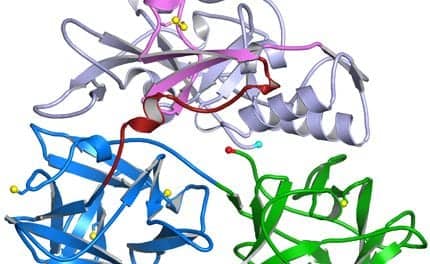Nutritional care for patients with ARDS includes fat and carbohydrate balance, micronutrients, and antioxidant intake.

Nutritional Intervention in ARDS
ALI and ARDS are associated with disease states characterized by a hypermetabolic response. Clinical states such as sepsis, pancreatitis, aspiration pneumonia, and severe trauma are associated with marked hypermetabolism secondary to the inflammatory process. Increased resting energy expenditure and increased protein catabolism resulting from hormonal alterations typify the hypermetabolic response to illness. Providing nutritional support to these patients early in their disease course is essential in order to minimize the loss of lean body mass and to provide adequate energy for metabolic support.1,2 As the American-European Consensus Conference on ARDS recommends, “Nutritional supplementation should be attempted after a few days of critical illness because of its associations with a more favorable outcome.”3
The route chosen for nutritional support will be determined by the patient’s underlying illness, with the primary focus falling on the level of gastrointestinal function. The American Society for Parenteral and Enteral Nutrition’s guidelines4 for nutritional support outline indications for parenteral nutrition; these include illnesses commonly seen in ALI and ARDS patients. Severe acute pancreatitis, intestinal failure, and sepsis-induced ileus are clinical conditions that warrant the use of parenteral nutrition.
Enteral nutrition is the preferred nutritional support method due to its reduced septic risk, lower cost, and role in maintaining the gastrointestinal barrier function. While primarily theoretical, translocation (or the breakdown of the mucosal barrier) is believed by some clinicians to be an important factor in the development of sepsis and multisystem organ failure.5 Evidence has demonstrated that enteral nutrition may, in fact, be superior to parenteral nutrition in affecting clinical outcome.6,7 While studies evaluating ARDS patients have not been performed, favorable data do exist for trauma and postoperative status, which are clinical states known to be etiologic factors in ARDS.
The choice of enteral access is best determined by the patient’s aspiration risk. Patients with a known potential for delayed gastric emptying (sepsis, diabetic gastroparesis, head trauma, or narcotic use) are most likely to benefit from postpyloric enteral tube placement.4 While this will not eliminate the risk of aspiration, it will minimize gastroesophageal reflux and will permit greater success in achieving the desired enteral intake levels.8
Determining Energy Requirements
Energy requirements among ARDS patients vary considerably based on the underlying clinical state. Increased energy expenditure is known to occur in sepsis, multiple trauma, pancreatitis, and other catabolic illnesses.4 Methods for determining energy requirements include measurement via indirect calorimetry (IC), calculation using the reverse Fick equation, and calculation via predictive equations.
IC is the most accurate method for measuring energy expenditure in hospitalized patients. Initial measurements are used at the time of nutritional support’s initiation. Subsequent measurements are used to assess changes in energy expenditure as a patient’s clinical condition changes.9,10 Despite its superiority, IC use in ARDS has its limitations. The table on page 48 outlines factors known to affect the reliability of IC measurements. ARDS patients often experience one or more of these variables during their treatment course. As the patient’s condition improves with subsequent ventilator changes, however, IC may produce reliable results.11
If an ARDS patient requires hemodynamic monitoring via pulmonary artery catheter, oxygen consumption (and, therefore, energy requirements) may be determined. This method, based on the reverse Fick equation, is useful when high ventilator settings make IC unfeasible.10
Predictive equations for estimating energy expenditure are useful for ARDS patients for whom IC is not obtainable and in whom no pulmonary artery catheter is present. Several equations exist for predicting energy expenditure, including the Harris-Benedict, Ireton-Jones, and Frankenfield equations. The correlation between estimates of energy expenditure obtained using these equations and the results of IC varies. An additional method for determining energy requirements is a general calculation using body weight. Providing the critically ill patient with 25 to 30 kcal/kg per day has been recommended.12-14
Patients with ARDS have increased protein requirements because of the rapid protein turnover known to occur in hypermetabolic states. In sepsis and trauma, protein requirements range from 1.2 to 2 g/kg per day (with adjustments made for renal or hepatic impairment).15,16
Providing carbohydrate in amounts that exceed 5 mg/kg per minute can increase the respiratory quotient beyond 1 and significantly increase work of breathing in severely stressed patients.15 Whether providing a nutritional support regimen with less than this amount of carbohydrate to patients with ARDS results in improved pulmonary function is unknown. It is known, however, that overfeeding will produce a significant increase in carbon dioxide production.17 This can be clinically significant in the patient with ARDS. Sullivan et al18 described a patient whose excessive hypercapnia could not be managed with high ventilator settings because significant barotrauma and high peak airway pressures were evident. The patient’s total energy intake was 48 kcal/kg. A reduced energy intake consistent with measured energy expenditure allowed changes in ventilation to reduce peak airway pressures, thus improving ventilator management.
Nutritional-support regimens that provide a balance of carbohydrate and fat as nonprotein energy should be adequate for optimal substrate utilization. If significant hypercapnia limits successful ventilator management and/or weaning, total energy intake should be evaluated to ensure that adequate (but not excessive) calories are provided. A reduction in carbohydrate intake may be useful if significant hypercapnia persists.15
Enteral Formula Selection
Early in the course of ARDS, patients frequently develop pulmonary edema. The selection of a nutrient-dense enteral formula is advantageous in limiting free water intake. As ARDS progresses to the fibroproliferative and fibrotic phases, pulmonary edema generally resolves. Selecting a nonconcentrated formula may be appropriate at this time.
An enteral product designed specifically for the ARDS patient is available. This product is a reduced-carbohydrate formula supplemented with eicosapentanoic acid and g-linolenic acid. It is known in ARDS that inflammatory mediators alter the metabolic pathways of these fatty acids, resulting in reduced levels of them. Eicosapentanoic acid and g-linolenic acid are precursors of prostaglandins of the 1 and 3 series and leukotrienes of the 5 series; these are compounds with beneficial anti-inflammatory properties that include vasodilation, inhibition of platelet aggregation, and reduced release of free oxygen radicals. In addition, increased amounts of eicosapentanoic acid and g-linolenic acid have been shown to decrease levels of the arachidonic acid metabolites thromboxane A2 and prostaglandin E2, which are associated with the inflammatory cascade and the resulting lung injury of ARDS.19
Preclinical animal research evaluating these polyunsaturated fatty acids led to the implementation of a multicenter, prospective, randomized, controlled trial comparing an enteral formula designed for ALI with an isocaloric, isonitrogenous enteral product. Gadek et al20 evaluated clinical outcomes in 98 patients with ARDS (as defined by the American-European Consensus Conference) randomized to receive either a formula supplemented with eicosapentanoic acid and g-linolenic acid or an equivalent product differing only in the lipid type. Baseline demographics and ventilatory parameters did not differ between groups. Patients received either formula at a minimum of 75% of estimated energy requirements calculated as 1.3 times basal energy expenditures for at least 4 to 7 days. Significant improvements in oxygenation by the fourth day of the study and reductions in both ventilator time (11±1.1 days versus 16.3±1.9 days, P=.011) and length of stay in the intensive care unit (12.8±1.1 days versus 17.5±1.7 days, P=.016) were demonstrated in the treatment group. In addition, only 4 of 51 patients receiving the treatment formula experienced new organ failures, compared with 13 of 47 patients receiving the control formula (P=.015). As an indicator of pulmonary inflammation, neutrophil recruitment was measured via bronchoalveolar lavage (BAL) at baseline and on the fourth and seventh study days. Patients who received the formula supplemented with eicosapentanoic acid and g-linolenic acid had a significantly lower number of neutrophils in recovered BAL fluid on the fourth study day and throughout the study period. These results support the idea that eicosapentanoic acid and g-linolenic acid, through their anti-inflammatory effects, may modulate the inflammatory response seen in ARDS.
Micronutrient Considerations
The function of selected micronutrients, including those that serve antioxidant roles, is important in the course of ARDS and must be considered in the care of patients. Minerals of specific importance include phosphorus and magnesium. Relevant antioxidants include vitamins E and C and the carotenoids.
Phosphorus is essential for diaphragmatic muscle function. In addition, it is required to maintain adequate2,3 bisphosphoglycerate levels, which are necessary for adequate oxygen release at the tissue level. Glucose intake can precipitate hypophosphatemia due to a rapid intracellular shift of phosphorus for utilization in adenosine-triphosphate–generating pathways.21 Hypophosphatemia is associated with impaired contractile properties of the diaphragm and can impair management of respiratory failure.22
Magnesium is required for cellular metabolism and is also important in muscle contraction. Hypomagnesemia can readily occur in ARDS patients due to diuretic use, concurrent hypophosphatemia, and/or hypokalemia.23
Recognition of the potential benefit of antioxidants in treating inflammatory processes such as ARDS is increasing. Oxidative stress via lipid peroxidation products, high oxygen concentrations, and excessive free radicals may be a factor in the cause of acute lung injury.24 The antioxidants vitamin E, vitamin C, and b-carotene function as antioxidants and have a potentially beneficial role in the course of ARDS. In addition, it is known that the antioxidative system is severely compromised in patients with ARDS. Metnitz et al25 demonstrated, in eight ARDS patients, reduced plasma levels of a-tocopherol, ascorbate, b-carotene, and selenium. They concluded that the routine replacement of micronutrients according to recommended daily allowances was inadequate to compensate for the increased requirements.
Vitamin E functions to prevent cellular lipid peroxidation induced by free radicals, thus protecting membrane lipids from destruction. Vitamin C functions synergistically by regenerating vitamin E.26 Due to the dual role of these antioxidants, it has been suggested that a mixture of nutrient antioxidants may be more beneficial than a single antioxidant as a defense in oxidative stress.27 While recognition of the potentially beneficial role of antioxidants in treating the inflammatory response exists, there are no specific recommendations for supplementation (beyond the recommended daily allowances) for the ARDS patient. b-Carotene also functions to prevent or treat the cellular damage caused by free radicals. There are no current recommendations for b-carotene supplementation for ARDS patients.
Conclusion
Nutritional support, preferably enteral, is essential when treating ARDS patients. Several considerations, including nutrient requirements, fat and carbohydrate balance, micronutrients, and antioxidant intake, should be addressed in the nutritional care of these challenging patients. An enteral formula supplemented with eicosapentanoic and g-linolenic acids may be a useful treatment option in the management of patients with, or at risk of developing, ARDS.
Ainsley M. Malone, MS, RD, LD, CNSD is a member of the Nutrition Support Team in the Pharmacy Department at Mount Carmel West Hospital in Columbus, Ohio.
References
1. Schwartz D. Pulmonary failure. In: Matarese LE, Gottschlich MM, eds. Contemporary Nutrition Support Practice: A Clinical Guide. Philadelphia: WB Saunders; 1998:395-409.
2. Hogg J, Kapholz A, Reid-Hector J. Pulmonary disease. In: Gottschlich MM, ed. The Science and Practice of Nutrition Support: A Case Based Core Curriculum. Dubuque, Iowa: Kendall/Hunt; 2001:493-514.
3. Bernard GR, Artigan A, Brigham KL, et al. The American-European Consensus Conference on ARDS: definitions, mechanisms, relevant outcomes and clinical trial coordination. Am J Respir Crit Care Med. 1994;149:818-824.
4. ASPEN Board of Directors. Guidelines for the use of parenteral and enteral nutrition in adult and pediatric patients. JPEN J Parenter Enteral Nutr. 1993;17:S17.
5. Lipman TO. Bacterial translocation and enteral nutrition in humans: an outsider looks in. JPEN J Parenter Enteral Nutr. 1995;19:156-165.
6. Moore FA, Moore EE, Jones TN. Total enteral nutrition vs total parenteral nutrition following major abdominal trauma: reduced septic morbidity. J Trauma. 1989;29:916-923.
7. Kudsk KA, Croce MA, Fabian TC, Minard G. Enteral versus parenteral feeding: effects on septic morbidity after blunt and penetrating abdominal trauma. Ann Surg. 1992;215:503-511.
8. Montecalvo MA, Steger KA, Farber HW, et al. Nutritional outcome and pneumonia in critical care patients randomized to gastric vs jejunal tube feedings. Crit Care Med. 1992;20:1377-1387.
9. Ireton-Jones CS. Indirect calorimetry. In: Skipper A, ed. Dietitian’s Handbook of Enteral and Parenteral Nutrition. Gaithersburg, Md: ASPEN; 1998:148-164.
10. Grant JP. Nutrition care of patients with acute and chronic respiratory failure. Nutrition in Clinical Practice. 1994;9:11-17.
11. McClave SA, Snider HL. Use of indirect calorimetry in clinical nutrition. Nutrition in Clinical Practice. 1992;7:208-221.
12. Shronts EP, Fish JA, Hammond K. Nutrition assessment. In: Merritt RJ, ed. The ASPEN Nutrition Support Practice Manual. Silver Spring, Md: ASPEN; 1998;1:1-17.
13. Ireton-Jones CS, Jones JD. Should predictive equations or indirect calorimetry be used to design nutrition support regimens? Predictive equations should be used. Nutrition in Clinical Practice. 1998;13:141-143.
14. Frankenfeld DC, Omert LA, Badellino MM, et al. Correlation between measured energy expenditure and clinically obtained variables in trauma and sepsis patients. JPEN J Parenter Enteral Nutr. 1994;18:398-403.
15. Ireton-Jones CS, Borman KR, Turner WW. Nutrition considerations in the management of ventilator-dependent patients. Nutrition in Clinical Practice. 1993;8:60-64.
16. Cerra FB, Benitez MR, Blackburn GL, et al. Applied nutrition in ICU patients: a consensus statement. Chest. 1997;111:769-778.
17. Burke JF, Wolfe RR, Mullany CJ, Mullany CJ, Mathews DE, Bier DM. Glucose requirements following burn injury. Ann Surg. 1979;190:274-288.
18. Sullivan DJ, Marty TL, Barton RG. A case of overfeeding complicating the management of adult respiratory distress syndrome. Nutrition. 1995;11:375-378.
19. Wennberg AK, Nelson JL, DeMichele SJ, Campbell AM. Affecting Clinical Outcome in Acute Respiratory Distress Syndrome with Enteral Nutrition. Columbus, Ohio: Abbott; 1997.
20. Gadek J, DeMichele S, Karlstad M, et al. Effect of enteral nutrition with eicosapentanoic acid, g-linolenic acid, and antioxidants in patients with acute respiratory distress syndrome. Crit Care Med. 1999;27:1409-1420.
21. Solomon SM, Kirby DF. The refeeding syndrome: a review. JPEN J Parenter Enteral Nutr. 1990;14:90-97.
22. Aubier M, Murciano D, Lecocguo Y, et al. Effect of hypophosphatemia on diaphragmatic contractility in patients with acute respiratory failure. N Engl J Med. 1985;313:420-424.
23. Crumbley J. Fluids and electrolytes. In: Cerra FB, ed. Manual of Critical Care. St Louis: CV Mosby; 1981:176-243.
24. Brandstetter RD, Sharma KC, DellaBadia M, Cabreros LJ, Kabinoff GS. Adult respiratory distress syndrome: a disorder in need of improved outcome. Heart Lung. 1997;26:3-14.
25. Metnitz PG, Bartens C, Fischer M, Fridrich P, Steltzer H, Druml W. Antioxidant status in patients with acute respiratory distress syndrome. Intensive Care Med. 1999;25:180-185
26. Davis WB, Pacht ER. Extracellular antioxidant defenses. In: Crystal RG, West JB, eds. The Lung: Scientific Foundations. New York: Raven; 1991:1821-1827.
27. Kelly FJ. Vitamin E supplementation in the critically ill patient: too narrow a view. Nutrition in Clinical Practice. 1994;9:141-145.









